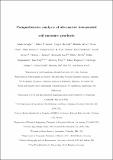Comprehensive analysis of alternative downscaled soil moisture products
Author(s)
Sabaghy, Sabah; Walker, Jeffrey P.; Renzullo, Luigi J.; Akbar, Ruzbeh; Chan, Steven; Chaubell, Julian; Das, Narendra; Dunbar, R. Scott; Entekhabi, Dara; Gevaert, Anouk; Jackson, Thomas J.; Loew, Alexander; Merlin, Olivier; Moghaddam, Mahta; Peng, Jian; Peng, Jinzheng; Piepmeier, Jeffrey; Rüdiger, Christoph; Stefan, Vivien; Wu, Xiaoling; Ye, Nan; Yueh, Simon; ... Show more Show less
DownloadAccepted version (4.005Mb)
Publisher with Creative Commons License
Publisher with Creative Commons License
Creative Commons Attribution
Terms of use
Metadata
Show full item recordAbstract
Recent advances in L-band passive microwave remote sensing provide an unprecedented opportunity to monitor soil moisture at ~40 km spatial resolution around the globe. Nevertheless, retrieval of the accurate high spatial resolution soil moisture maps that are required to satisfy hydro-meteorological and agricultural applications remains a challenge. Currently, a variety of downscaling, otherwise known as disaggregation techniques have been proposed as the solution to disaggregate the coarse passive microwave soil moisture into high-to-medium resolutions. These techniques take advantage of the strengths of both the passive microwave observations of soil moisture having low spatial resolution and the spatially detailed information on land surface features that either influence or represent soil moisture variability. However, such techniques have typically been developed and tested individually under differing weather and climate conditions, meaning that there is no clear guidance on which technique performs the best. Consequently, this paper presents a quantitative assessment of the existing radar-, optical-, radiometer-, and oversampling-based downscaling techniques using a singular extensive data set collected specifically for that purpose, being the Soil Moisture Active Passive Experiment (SMAPEx)-4 and -5 airborne field campaigns, and the OzNet in situ stations, to determine the relative strengths and weaknesses of their performances. The oversampling-based soil moisture product best captured the temporal and spatial variability of the reference soil moisture overall, though the radar-based products had a better temporal agreement with airborne soil moisture during the short SMAPEx-4 period. Moreover, the difference between temporal analysis of products against in situ and airborne soil moisture reference data sets pointed to the fact that relying on in situ measurements alone is not appropriate for validation of spatially enhanced soil moisture maps.
Date issued
2020-01Department
Massachusetts Institute of Technology. Department of Civil and Environmental EngineeringJournal
Remote Sensing of Environment
Publisher
Elsevier BV
Citation
Sabaghy, Sabah, et al. "Comprehensive analysis of alternative downscaled soil moisture products." Remote Sensing of Environment, 239 (March 2020): 111586.
Version: Author's final manuscript
ISSN
0034-4257